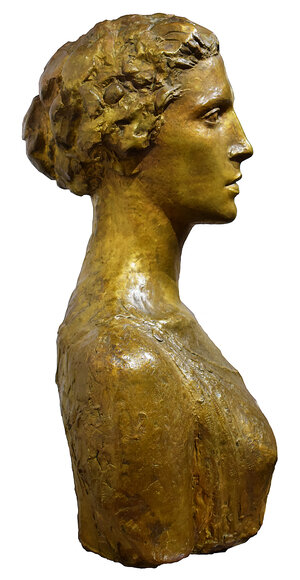

(Mont-de-Marsan, 1874 - Paris, 1946)
Madame Paul-Louis Weiller, dite aussi La Grecque, Circa 1944 -1946
Original bronze with gold patina
Cast, Bisceglia, Paris
Foundry stamp on the back on the right shoulder CIRE PERDUE / BISCEGLIA
Signed and numbered under the left breast C. Despiau 7/10
Re-signed on the back on the right shoulder C. Despiau
Height: 60 cm Width: 47 cm Depth: 27.5 cm
Work initiated around 1932 and completed around 1944-1946
Limited edition of 10 each numbered out of 10
According to Elisabeth Lebon, bronze by Bisceglia from 1947 authorized by Mrs. Charles Despiau
Exhibitions:
- Salon des Tuileries, Paris, 1937, an unfinished cast under the number 481 - Charles Despiau Sculptures et Dessins, Musée Rodin, Paris, 1974, another proof of the same model (numbered 9/10, collection of the Despiau-Wlérick Museum, Mont-de-Marsan) under the number 86
- Charles Despiau 1874-1946, traveling exhibition under the direction of Tetsuo Sakai in 7 museums in Japan, another proof of the same model (numbered 9/10, Despiau-Wlérick Museum Coll., Mont-de-Marsan) under number 59:
. The Miyagi Museum of Art, June 7 to July 13, 1997
. Mie Prefectoral Art Museum, from July 19 to August 24, 1997
. Kumamoto Prefectoral Museum of Art, September 4 to October 5, 1997
. Ohara Museum of Art, October 11 to November 16, 1997
. Yamanashi Prefectural Museum of Art, November 22 to December 21, 1997
. Hyogo Prefectural Museum of Modern Art, Kobe, January 6 to February 8, 1998
. The Museum of Modern Art, Ibaraki, February 14 to March 22, 1998
- Charles Despiau Hommage à Baudelaire, traveling exhibition:
. Bordeaux Musée des Beaux-Arts, Bordeaux, 18 June to 18 September 2005
. Libourne Musée des Beaux-Arts, Libourne, 18 June to 18 September 2005
. Musée Despiau-Wlérick, Mont-de-Marsan, from October 8, 2005 to January 16, 2006, another cast (numbered 9/10, collection of the Musée Despiau-Wlérick, Mont-de-Marsan)
Selective literature:
- Regards sur l’œuvre de Charles Despiau by Léon Deshairs, 1937, another proof reproduced p. 140
- Sculpteurs de ce temps, by Jacques Baschet, New French Editions, Paris, 1946, plaster reproduced p. 37
- Despiau vivant L’homme et l’œuvre by Waldemar George, editions Paul Dupont, 1947, original size plaster reproduced pl. 8
- Despiau by Maximilian Gautier, Gemini, Paris, 1949, another proof of the same model reproduced pl. XIX
- Ch. Despiau by W. George, 1954, another proof of the same model reproduced pl. 26
- Dictionnaire universel de l’art et des artistes by J.-E. Muller, Paris, 1967, another proof of the same model reproduced on p. 389
- Charles Despiau Sculptures et dessins, catalogue of the exhibition of the Musée Rodin, Paris, 1974, texts by Monique Laurent and Claude Roger-Marx, another proof of the same model is described and reproduced under the number 86
- Charles Albert Despiau (1874-1946), Collections of the Musée Municipal of Mont-de-Marsan, 1982, another proof of the same model (cast Bisceglia numbered 9/10, collection of the Musée Despiau-Wlérick, Mont-de-Marsan) is described and reproduced as No. 64 at p. 52
- Charles Despiau (1874-1946) Catalogue Raisonné de l’Œuvre Sculpté by Elisabeth Lebon, PhD Thesis of Art History, University Paris I Panthéon-Sorbonne, unpublished, 1995, catalogue 135
- Charles Despiau 1874-1946, catalogue of the traveling exhibition in Japan, notices by Elisabeth Lebon, The Yomiuri Shimbun & The Japan Association of Art Museums Spatial Design Consultants Co. Ltd., 1997, another test of the same model described in the pages 207 and 208 and reproduced in color at p. 164 under the number 59
- Charles Despiau Hommage à Baudelaire, catalogue of the traveling exhibition of the Musée des Beaux-Arts of Bordeaux, the Musée des Beaux-Arts of Libourne and the Museum Despiau-Wlérick, Mont-de-Marsan, texts by Ludivine Alégria, Olivier Le Bihan, Marguerite Stahl, Alexandre Péraud and Marie-Christine Hervé, editions Le Festin, 2005, another proof of the same model (circa 1944-1946, collection of the Musée Despiau-Wlérick, Mont-de-Marsan) is reproduced in color at the p. 8
- This sculpture will be included in the Catalogue critique de l’oeuvre sculpté de Charles Despiau being prepared by the Galerie Malaquais under the direction of Élisabeth Lebon.

In 1932, Major Paul-Louis Weiller (1893-1993), an important industrialist in aeronautics, married for the second time, Miss Aliki Diplarakou, (1912-2002) daughter of an Athenian lawyer. Two years earlier, in 1930, she was elected Miss Europe. Paul-Louis Weiller asked Despiau to make the bust of his new and lovely wife. The arrival in the sculptor's studio of this young Greek girl of such beauty excited Despiau, who was in love with classical Greece. However, Mrs. Paul-Louis Weiller did not support the numerous and constraining sessions, which were distilled over several years. Despiau decided to show the unfinished work at the Salon des Tuileries in 1937. The bust, first designed "antique" on a pedestal, was enlarged in torso, letting dawn chest erect. The sculpture was a great success and Despiau had a clay test done but refused to cast a bronze edition. The war, and the shortage of models which it provoked, forced Despiau to take back some unfinished old works. Thus, the sculptor reworked his portrait of Madame Paul-Louis Weiller, dressing her with a draped toga.
About this sculpture Elisabeth Lebon writes: "This bust with proportions slightly superior to nature, which has for first quality the monumentality, moves away from the melodic rhythm, intimate of the most beautiful works of the previous Despiau, and opens the way in the the career of the sculptor to all the following series of classical works of spirit where the power seems to have to prevail over the sensibility. It remains however as one of the most famous busts of Despiau. "